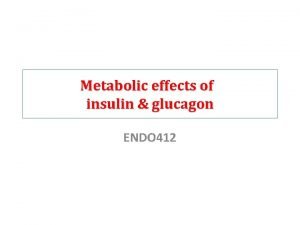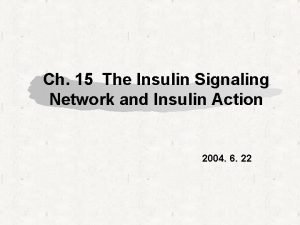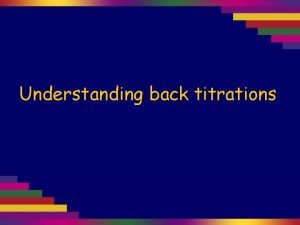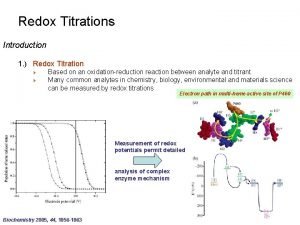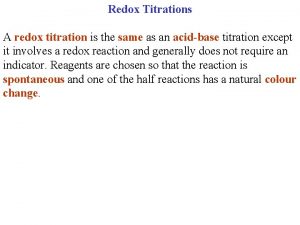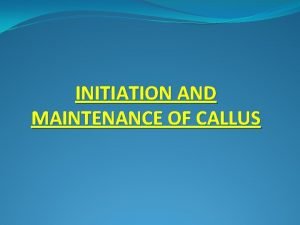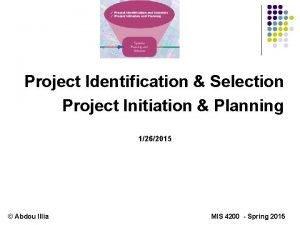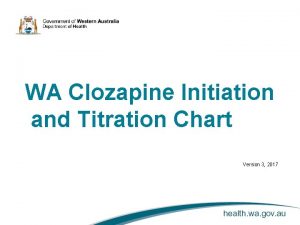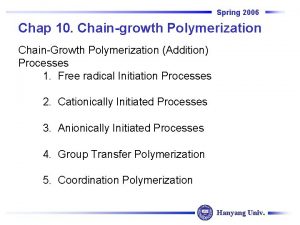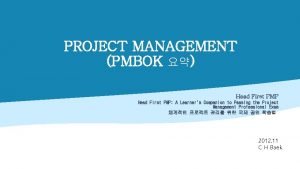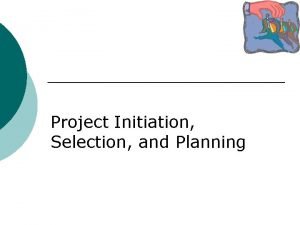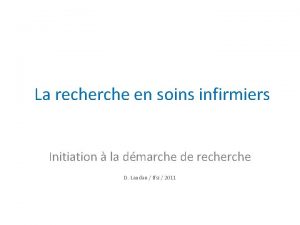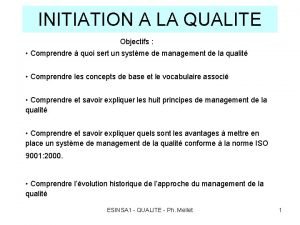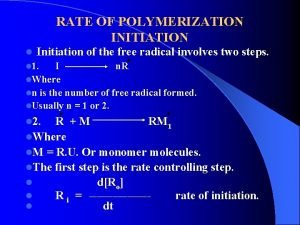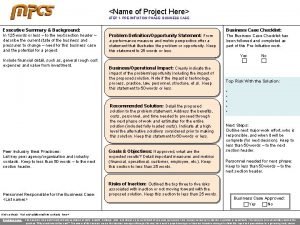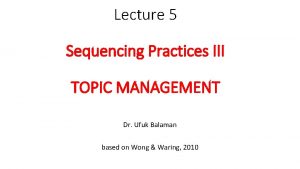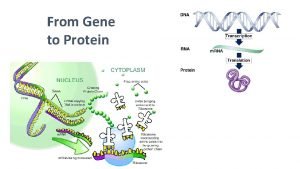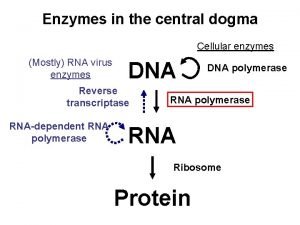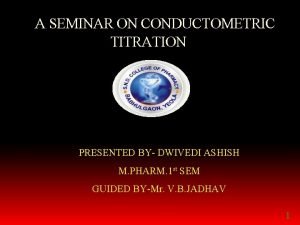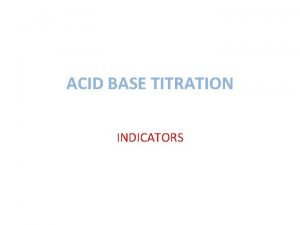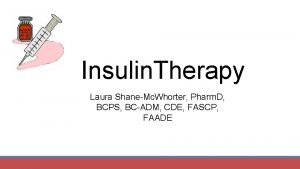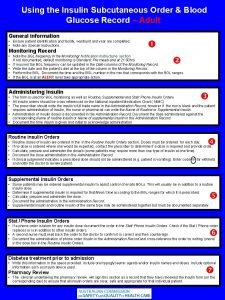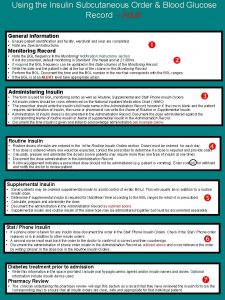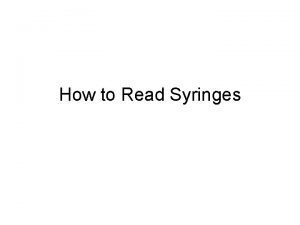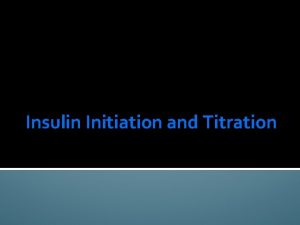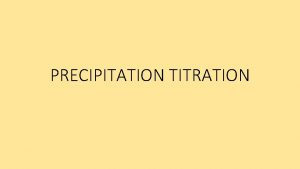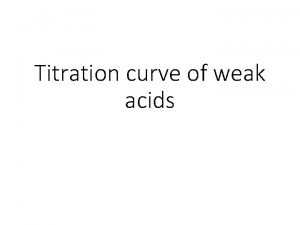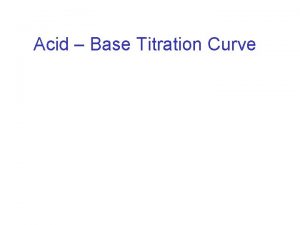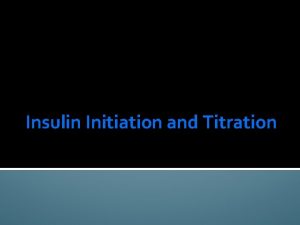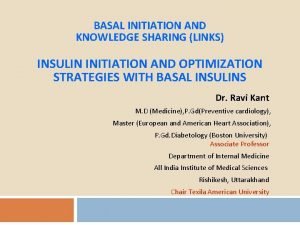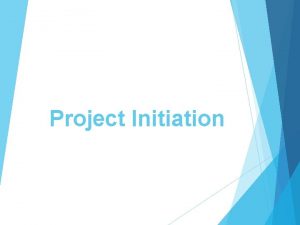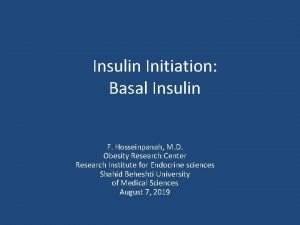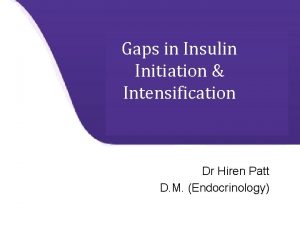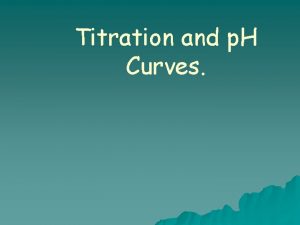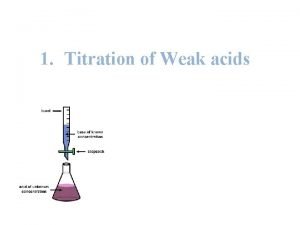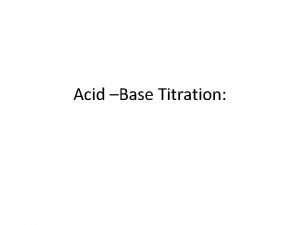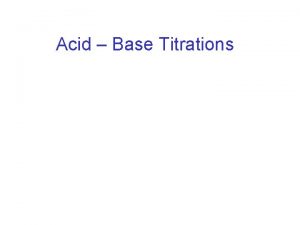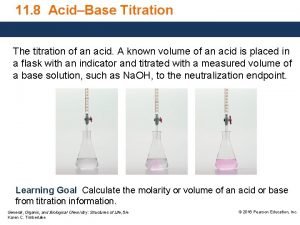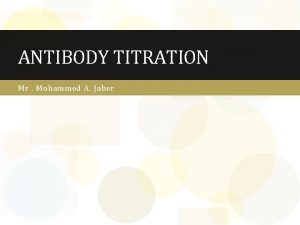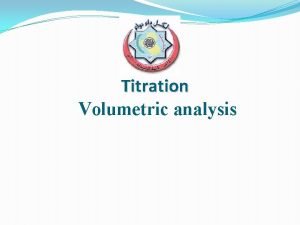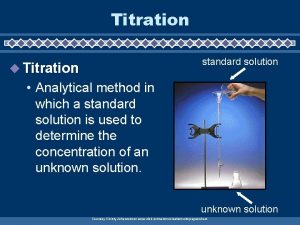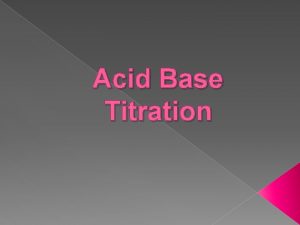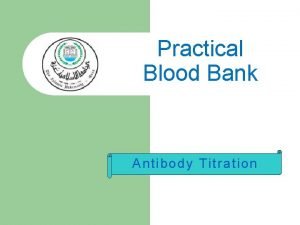Insulin Initiation and Titration Insulin topics we will




















































- Slides: 52

Insulin Initiation and Titration

Insulin topics we will not cover today �Inhaled Insulin �Insulin Pump �Insulin management of the surgical and ICU patient �Insulin Requirements in Pregnancy

Goals for this session: �Know the indications for starting insulin �Know typical starting dose of Daily intermediate or long-acting insulin �Titrate the intermediate or long-acting insulin based on glucose readings �Be able to calculate starting doses based on weight for 70/30 insulin BID dosing �Titrate the 70/30 insulin based on glucose readings �Identify causes of hypoglycemia and hyperglycemia �Manage hypoglycemia and hyperglycemia

Complete 3 activities after this lecture �Calculating Insulin Starting Doses and Titration Case Studies �How to draw up and inject insulin �Hypoglycemia & Hyperglycemia identification & treatment. Glucose monitoring and the importance of the glucose logbook in titrating insulin doses.

Insulin types

Insulin Terms �Basal Insulin Replacement That insulin required to suppress hepatic glucose production overnight and between meals

Basal Insulin Action Product When to Take Onset Peak Duration 14 -26 hours Intermediate NPH Does not 1 -4 hours need to be given with a meal 4 -12 hours Long Usually bedtime* Throughout Up to 24 the day hours Glargine (Lantus) Determir (Levermir) 1 -2 hours

Insulin Terms �Bolus (prandial or mealtime) insulin replacement That insulin required to utilize glucose after eating �Correction dose (also called supplement) Additional insulin for pre-meal hyperglycemia Can also be between-meal hyperglycemia This insulin can only be regular, lispro, aspart, or glulsine

Bolus & Correction Insulin Action Product When to Take Onset Peak Duration Rapid Lispro (Humalog) Aspart (Novo. Log) Glulisine (Apidra) 0 -15 minutes before a meal 10 -30 minutes - 3 -5 hours 3 hours Short Regular (R) Human 30 minutes before a meal 30 minutes 1 -5 hours 8 hours With the exception of marked hyperglycemia (correction dose) do NOT administer bolus insulin (rapid or short acting) without the patient eating afterwards or hypoglycemia will occur.

Pre-mixed RAPID ACTING WITH INTERMEDIATE SHORT ACTING WITH INTERMEDIATE � Humalog Mix 75/25 � Humalog Mix 50/50 � Novolog Mix 70/30 � Humulin 50/50 � Novolin 70/30

What is the shelf-life of insulin after it is opened? 28 DAYS 7 -14 DAYS

Care of Insulin �Intermediate-acting insulins that are not refrigerated should be kept as cool as possible [<86°F], but not frozen. �Insulin glargine, once opened, should be stored in a refrigerator or kept as cool as possible. �Advise patients that all insulins need to be stored out of direct sunlight and kept from extremes of temperature.

When should you start insulin? �Type I Diabetes Always

When should you start insulin in Type II Diabetes? Glucose levels are so acutely elevated that immediate safety is a concern ▪ Marked hyperglycemia OR Significant weight loss OR Severe/significant symptoms OR 2+ or greater ketonuria OR DKA/ hyperosmolar state OR Severe intercurrent illness or surgery Chronic suboptimal control of glucose despite oral hypoglycemic medications/GLP-1 agonists/ ▪ Fasting Plasma Glucose > 140 OR 2 Hr Postprandial Plasma Glucose > 180 OR A 1 C > 7. 0%

What fears do patients have about starting insulin?

Insulin Initiation Options for Type II Patients

Insulin options for patients with Type II DM 1) Continue PO medications & add nighttime basal insulin 2) Pre-mixed Insulin Program 3) Basal insulin + mealtime (bolus) insulin We will not cover this today

Option #1: Continue PO medications & add nighttime basal insulin NOTE: This is NOT an option for patients with Type II DM who have an A 1 c >8. 5% on max oral hypoglycemics (they will never get to goal). 2) This is NOT an option for Type I diabetics 1)

PO medications + Basal Insulin Initiation Continue oral agents Add single dose nighttime basal insulin (intermediate {NPH} or long acting insulin {glargine or determir}) 3) Begin with a single dose of 10 Units at bedtime (start with lower doses in elderly patients, CKD, and patients taking sulfonylurea + GLP-1 agonists) 1) 2)

PO medications + Basal Insulin Titration �Check and log daily morning (fasting) blood glucose �Keep increasing the night time basal insulin by 2 units every 3 days until morning (fasting) blood glucose is consistently less than 130 �If hypoglycemia occurs or AM blood glucose is <70 on any one reading, Decrease nighttime basal insulin by 4 units.

EXAMPLE �A 84 kg male has consistent elevated glucose readings, and A 1 C of 7. 8 on Metformin 1 g BID, Glyburide 10 mg BID, and Pioglitazone 30 mg daily. The patient has normal estimated Cr. Cl. �Plan: Nighttime basal insulin: glargine or determir or NPH is added to the patient’s medications

EXAMPLE �Q: The patient was started on 10 Units of nighttime glargine in addition to his PO medications: glyburide 5 mg BID, Metformin, 1 g BID, and Pioglitazone 30 mg daily. He checks his fasting glucose every morning and calls you with the following AM results from the past 4 days: 180, 160, 173. What should be done next? �A:

EXAMPLE �Q: The patient calls you in 4 days with the following AM fasting readings: 136, 128, 134, What should you tell the patient? �A:

EXAMPLE �Q: The patient calls you in 4 days with the following AM fasting readings: 102, 98, 88. What should you tell the patient? �A:

Option #2: Pre-mixed Insulin Program 70/30 or 75/25 or 50/50 insulin

Premixed Insulin Program �Taper and discontinue oral antihyperglycemic medications as insulin is initiated and adjusted, particularly if using short or rapid-acting + basal insulins (exception is METFORMIN - Type 2 diabetics on insulin can improve their glycemic control and lower their insulin dose with metformin. ) �There is an increased risk for edema when insulin and a thiazolidinedione are used together. Rosiglitazone should not be used in combination with insulin.

Pre-mixed Insulin Initiation � Calculate Total Daily Insulin Requirement = 0. 5 Units/Kg (consider lower if the patient is very active, elderly, has chronic kidney disease, or is taking Metformin) � 70/3 o insulin: give 2/3 QAM (before breakfast) and 1/3 QPM (before dinner) *** Do NOT administer premixed insulin without eating afterwards – hypoglycemia will occur. Short acting intermediate – give 30 minutes before breakfast and dinner Rapid acting intermediate – give right before breakfast and dinner. “give the shot while the meal is hot”

PRACTICE �Calculate your own total starting dose of 70/30 insulin based on your weight in Kg. Now divide total into 2/3 in the AM (pre-breakfast) and 1/3 in the PM (pre-dinner)

Example �Q: Calculate the insulin for a patient starting 70/30 insulin who is 200 lbs �A:

Example �Q: Calculate the insulin for a patient starting 70/30 insulin who is 140 lbs (64 kg) �A:

70/30 Insulin Titration �Check glucose & log readings at least twice a day – pre breakfast and pre dinner (or with any signs of hyper or hypoglycemia) *Important – pre breakfast glucose reading reflects the amount of insulin given pre dinner. Pre dinner glucose reading reflects the amount of insulin given pre breakfast.


70/30 Insulin Titration Monitor and log readings for 3 days: If pre breakfast glucose is >130 INCREASE pre dinner insulin by 2 units If pre dinner glucose is >130 INCREASE pre breakfast insulin by 2 units If pre breakfast glucose is >200 INCREASE pre dinner insulin by 4 units If pre dinner glucose is >200 INCREASE pre breakfast insulin by 4 units * If unexplained hypoglycemia (any reading <70), decrease the insulin by 4 units. (example – pre dinner glucose is 68 that is not explained by any change in eating/activity – decrease the pre-breakfast insulin by 4 units)

EXAMPLE – 70/30 insulin �Your patient is taking 70/30 insulin 20 Units before breakfast and 12 Units before dinner returns with the following glucose readings �Pre breakfast 20 U Pre dinner 12 Units 300 220 253 215 � Plan?

EXAMPLE – 70/30 insulin �For the next 2 days, the glucose readings on 24 units QAM & 16 units QPM are: �Pre breakfast Pre dinner 102 167 118 140 �Plan?

EXAMPLE – 70/30 insulin �Now the patient has the following readings on 26 Units QAM and 16 Units QPM �Pre breakfast Pre dinner 60 (skipped dinner the night before) 220 116 210 Plan?

EXAMPLE 70/30 insulin titration �Now the patient has the following readings on 30 Units QAM and 16 Units QPM �Pre breakfast Pre dinner 92 115 127 132 Plan?

Option #3: Basal insulin + mealtime (bolus) insulin For Type II patients who require insulin For Type I patients

Step 1 �Calculate Total Daily Insulin = 0. 5 units x weight (kg). �EXAMPLE. If a patient weighs 100 kg, the total daily insulin = 50 units/day If the patient is very active, has decreased creatinine clearance, or is on diabetic medications, then consider a lower weight dose (ie 0. 3 units x weight (kg)). EXAMPLE 100 kg patient total insulin dose = 30 units/day.

Step 2 �Split Total Insulin dose 50: 50 basal and bolus insulin 50% of dose is basal 50% of dose is bolus between ▪ Further divide bolus insulin into 1/3 for 3 meal coverage.

Example using Glargine or Determire once daily dosing for Basal Insulin for a 100 kg person Total Insulin Dose = 50 units Mealtime or Bolus insulin (lispro, aspart, gluisine, regular) 25 Units Breakfast 8 Units Lunch 8 Units Dinner 8 Units Basal (Glargine or Determire) Insulin 25 Units Bedtime 25 Units

Question? �Calculate Insulin dosing for a 60 kg person using Glargine Basal Insulin and Regular Bolus insulin Total Insulin Dose = 30 Units Total Daily Glargine Insulin is 15 Units & Total Regular Insulin is 15 Units Regular insulin: 5 Units before Breakfast, 5 Units before Lunch, 5 U before Dinner. Glargine 15 Units at bedtime.

Insulin Titration �Have the patient check glucose readings at least 3 times a day in the log book – goal (fasting 90120) and (3 hour post meal <160). �If fasting blood glucose is consistently >120 -130, increase the basal insulin (NPH or glargine, determir) by 2 -4 units a week. �If 2 -3 hour post meal is consistently > 160, increase bolus insulin (lispro, aspart, gluisine, regular) by 2 -4 units Example – if 3 hour post breakfast is consistently 200, however, all other glucose readings are well controlled…increase the pre-breakfast bolus insulin by 2 -4 units

What about the high readings?


If the patient has persistent high glucose readings despite multiple titrations of insulin, think of: � Incorrect Insulin Administration (Watch the patient’s technique in your office) Drawing up air and injecting it (instead of insulin) Not injecting the insulin SC Not rotating injection sites � Dietary Non-compliance, weight gain � Insulin Non-compliance/Skipping Doses � Infection � False readings – re-check glucometer & strips, check A 1 c and compare home glucose reading with clinic glucometer � Outdated insulin or insulin exposed to extreme temps.

And the low readings?

If the patient has low readings, think of �False readings – re-check glucometer & strips, check A 1 c and compare home glucose reading with clinic glucometer �Insulin overdose �No PO intake, change in eating habits �Weight loss (chronic low readings) �Renal failure (acute if sudden hypoglycemia on same dose of insulin)

Summary

Take Home Message �Insulin Initiation Better to start lower and titrate upwards than have a patient experience hypoglycemia (especially in older patients) �Insulin Titration It takes time and constant titration to get patient at goal ▪ Follow patients closely (phone, e-mail) for insulin titration. ▪ Make sure the patient has a phone number to call with any questions or concerns. ▪ Educate the patient on the sign/symptoms & treatment of hyper & hypoglycemia �Know when to refer the patient to a diabetes specialist

References Joslin Diabetes Center & Joslin Clinical Guideline for Pharmacological Management of Type 2 Diabetes 1/09/2009 www. professionaled. joslin. org 2) Joslin E-Z start Resource Manual for Primary Care Practices 3) Uptodate. com 1)

Learning Outcomes for PD Lab Stations �Effectively dose and titrate insulin for the cases given �Demonstrate correct drawing up insulin and injection of insulin Be able to instruct patients on this technique �Demonstrate correct technique of checking a capillary blood glucose Be able to instruct patients on this technique �Identify the signs and symptoms of hyperglycemia and hypoglycemia
 Effect of insulin on carbohydrate metabolism
Effect of insulin on carbohydrate metabolism Insulin and insulin receptor
Insulin and insulin receptor Titration vs back titration
Titration vs back titration Precipitation titration calculations
Precipitation titration calculations Titration curve of permanganometric
Titration curve of permanganometric Acid base titration vs redox titration
Acid base titration vs redox titration Titration insulin
Titration insulin Insulin dose calculation pdf
Insulin dose calculation pdf Is responsible for all file i/o initiation and termination
Is responsible for all file i/o initiation and termination Initiation and maintenance of callus culture
Initiation and maintenance of callus culture Project selection process
Project selection process Clozapine titration chart
Clozapine titration chart Rna polymerase
Rna polymerase What is the ordeal in the odyssey
What is the ordeal in the odyssey Kinetic chain reaction
Kinetic chain reaction Project initiation document
Project initiation document Importance of project initiation
Importance of project initiation Initiation à la recherche en soins infirmiers
Initiation à la recherche en soins infirmiers Site initiation visit ppt
Site initiation visit ppt Tahap inisiasi proyek
Tahap inisiasi proyek Phases of home visiting
Phases of home visiting Dauntless initiation
Dauntless initiation Light vs darkness archetype
Light vs darkness archetype Site initiation visit
Site initiation visit Sensibilisation et initiation à la cybersécurité
Sensibilisation et initiation à la cybersécurité Bonding relationship stage
Bonding relationship stage A quoi sert la qualité
A quoi sert la qualité L'initiation
L'initiation Initiation à la démonstration 5ème
Initiation à la démonstration 5ème Ccc 1326
Ccc 1326 Hero's journey revelation
Hero's journey revelation Revelation in hero's journey
Revelation in hero's journey Peace amplifier
Peace amplifier Pre initiation phase project management
Pre initiation phase project management Stepwise topic shift
Stepwise topic shift Initiation promotion progression
Initiation promotion progression Initiation complex
Initiation complex Dna central dogma
Dna central dogma Advantages of conductometry
Advantages of conductometry Weak acid strong base titration curve
Weak acid strong base titration curve How to read a titration curve
How to read a titration curve Insulin and sodium retention
Insulin and sodium retention Insulin and glycolysis
Insulin and glycolysis Nph onset and peak
Nph onset and peak What is 2,3 bpg
What is 2,3 bpg Clearsafe blood control slide
Clearsafe blood control slide Insulin subcutaneous order and blood glucose record
Insulin subcutaneous order and blood glucose record Norditrophin
Norditrophin How much is 0.5 ml in a syringe
How much is 0.5 ml in a syringe Informative and surprising essay topics
Informative and surprising essay topics General question in research
General question in research Classification and division
Classification and division Cs 527 uiuc
Cs 527 uiuc
